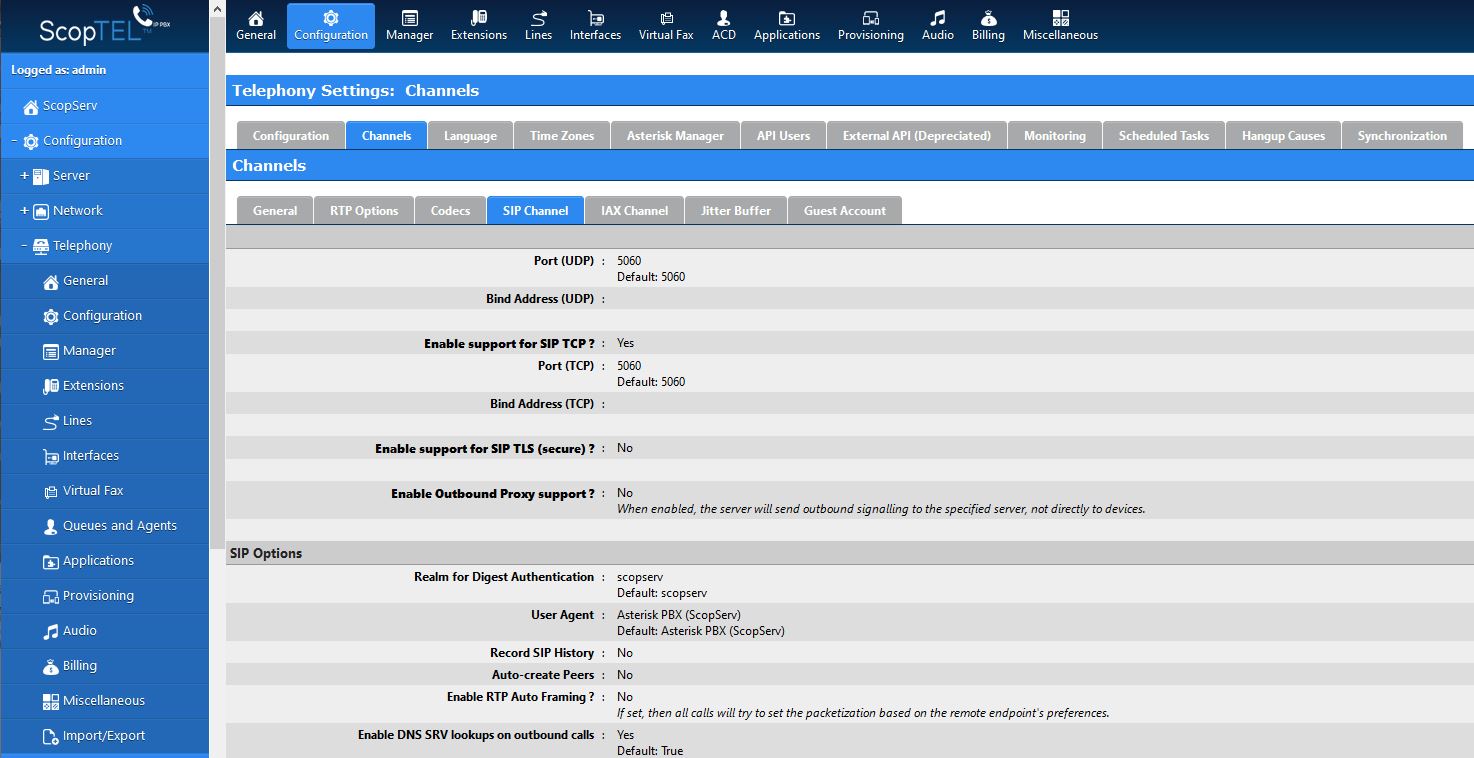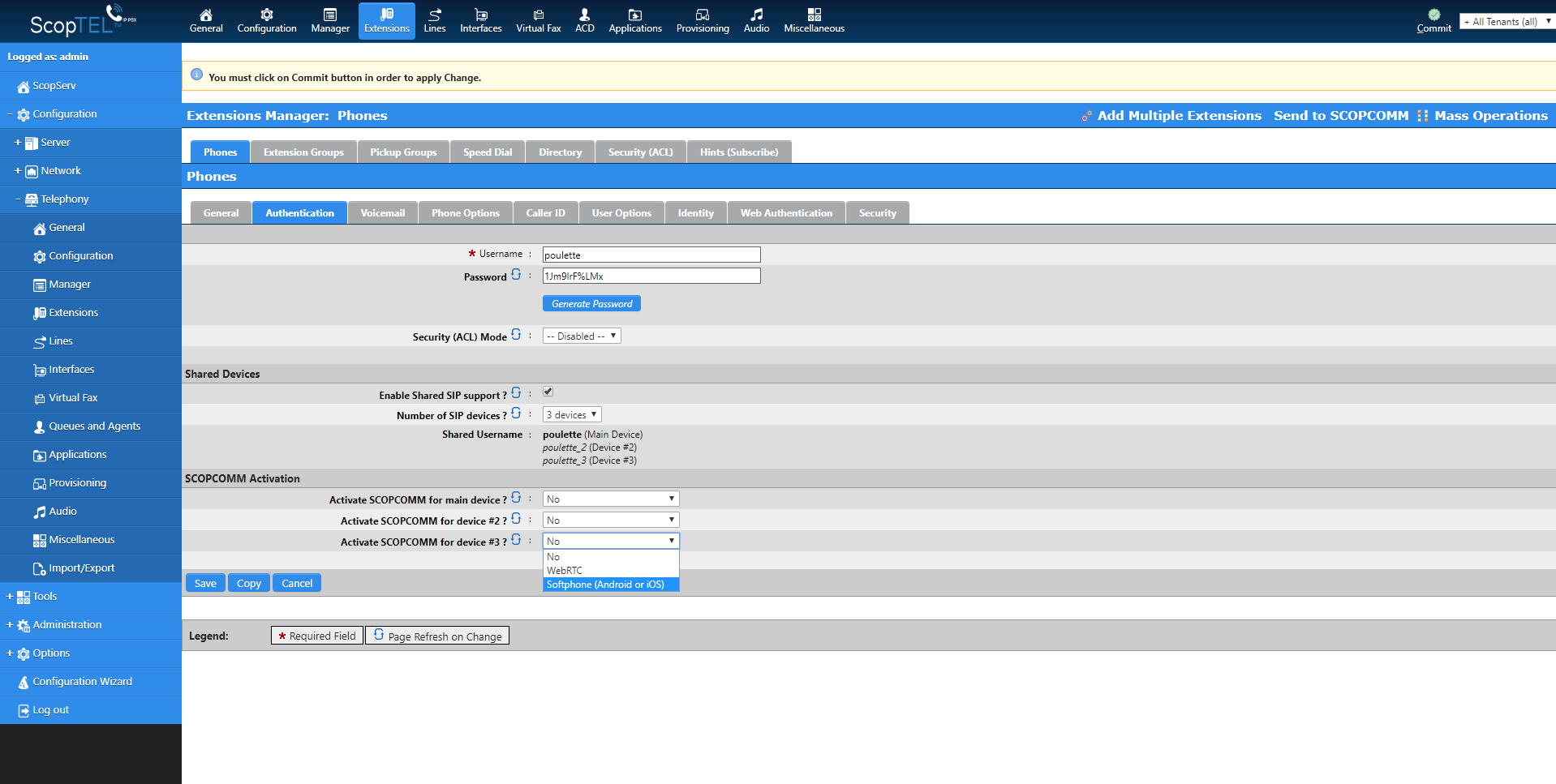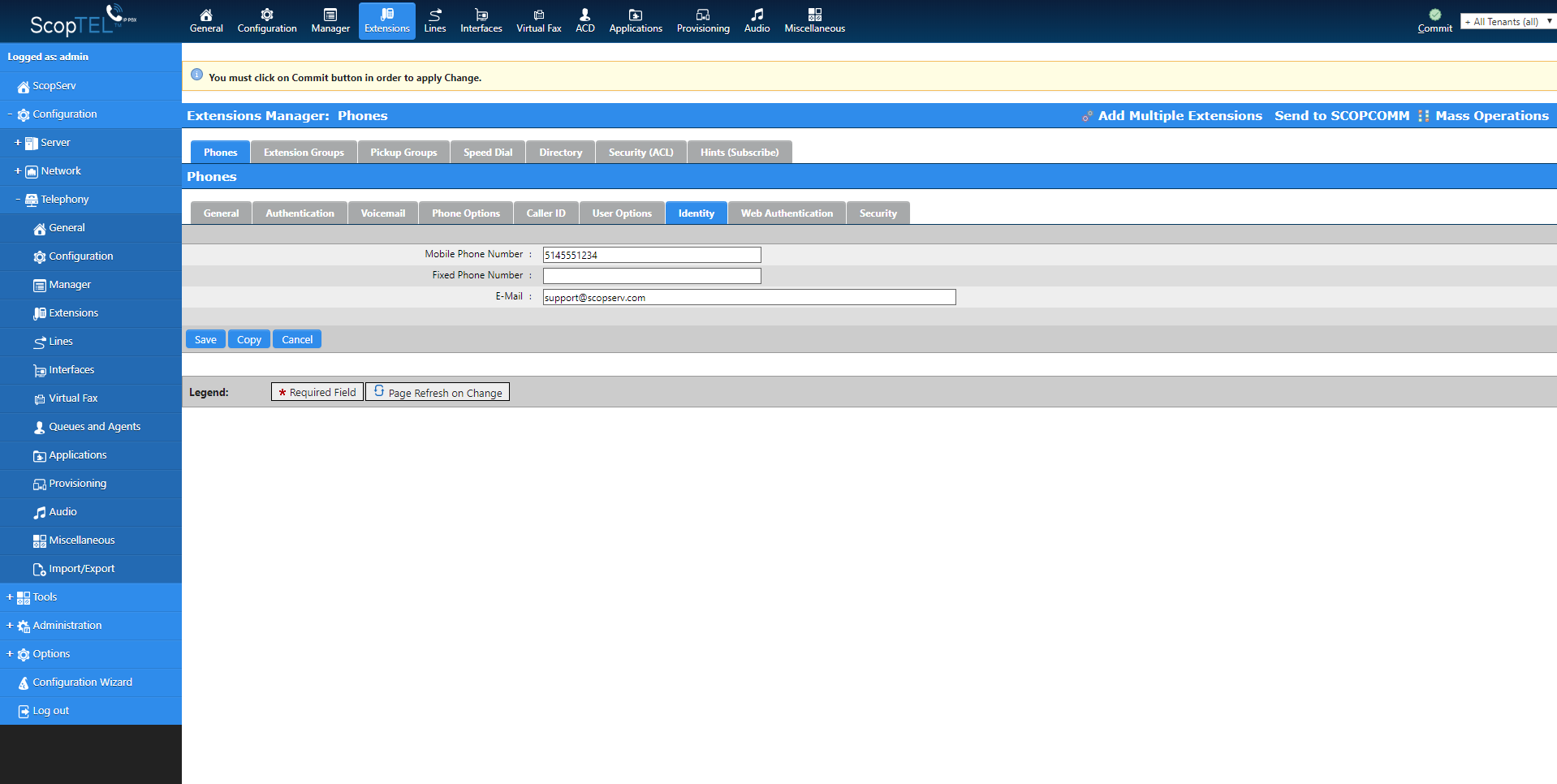SCOPCOMM Admin Guide
Introduction
- SCOPCOMM for iPhone, available on iOS App Store
- SCOPCOMM for Android, available on Android Google Play
- SCOPCOMM Desktop for Windows
- SCOPCOMM Desktop for MacOS
SCOPTEL also offers the following WebRTC solutions:
- SCOPCOMM WebRTC available at http://rtc.scopserv.com
- SCOPCOMM WebRTC Windows
- SCOPCOMM WebRTC MacOS
Licences
Requirements


You must have SCOPTEL installed and running with a valid licence. It is also important that in the case you have a firewall between your server and Internet access, it must not block traffic to and from certain addresses (ask your provider). Otherwise, it will not be possible to support provisioning and basic SCOPCOMM services.
If you set up Security (ACL) rules in SCOPTEL, make sure you allow the following IP addresses, otherwise WebRTC users will not be able to connect to your PBX:
- 75.98.128.37
- 75.98.128.38
Your installation’s firewall must allow the following ports:
- 5060 (UDP)
- 5060 (TCP), or 5061 (TLS) if you need high-level encryption
- 10000 to 20000 (UDP)

Additionally, if your server is in a NAT (network address translation) network, you must configure the server address:
- In SCOPTEL, go to Configuration > Telephony > Configuration > General.
- Make sure that the Server behind NAT is active.
- Write the public IP address just below.
- Press the Commit button.
Please note that the public IP address must be static. If this is not the case, contact your Internet service provider to obtain one. For more information on SCOPTEL and NAT, please read https://service.scopserv.com/portal/en/kb/articles/scoptel-certificate-manager

You can use the yougetsignal public utility (https://www.yougetsignal.com/tools/open-ports/) to check that your system is really reachable from Internet. You should test your server address with ports 5060 and 10000 to quickly check that your firewall rules are correct.
Security and Encryption
SCOPTEL Configuration
- In SCOPTEL, go to Configuration > Telephony > Configuration > Channels > SIP Channel.
- Make sure that the Enable Support for SIP TCP option is active and in the TCP Port write 5060 (or your TCP or TLS port setting).

- Got to Configuration > Network > Firewall > Advanced Rules.
- Find and edit entry VoIP (SIP/IAX/MGCP) and add this rule: 5060/tcp (substitute your TCP or TLS port setting).
- Click Commit.
- Go to Configuration > Network.
- Click Restart Service.
SCOPCOMM Configuration
If the public address/domain or ports of your network are not the same as that of your installation, this is where you must specify them. For example, if you use a firewall or SBC that has different values, this is where you must specify it. This address and port are the ones visible to devices on the public network.
- In SCOPTEL, go to Configuration > Telephony > Configuration > SCOPCOMM.
- Click Edit.
- Write the public IP address or domain of your installation.
- Set an administrator e-mail.
- Select a destination for provisioning e-mails. The options are:
- Administrator: the admin e-mail configured on this page is the only recipient of provisioning info.
- End user: end users will get the provisioning e-mail at the address configured under their profile.
- Both
- If your public ports are not the same as your installation’s ports, first click “Specify custom public ports” and type in the ports for each protocol (UDP, TCP, TLS).
- Click Save.
Provisioning
- In SCOPTEL, go under Configuration > Telephony > Extensions.
- If you want to add a SCOPCOMM account to an existing extension, click click the edit button next to the extension of your choice and go to step 4.
- To create a new extension with SCOPCOMM, click Add a new phone. Under the General tab, select the tenant (if you are in a multi-tenant site.
- Under the General tab, select phone type SIP and click Add/Save.
- Under the Authentication tab, type a username and password.
- If you want to enable SCOPCOMM for multiple devices or for a device other than the main one, check Enable Shared SIP support. This will automatically add another SIP device. You can have up to three devices per extension.

- For each device select if you want activate SCOPCOMM on softphone or WebRTC. You may also choose to not activate SCOPCOMM for that device.
- Under the Phone Options tab, set the following:
- Transport Mode: UDP and TCP (or TLS is you have SSL security set up on your system)
- Phone behind NAT: selected if you are in a NAT network
- Codec: H.264 Video
- Under the Identity tab, write the user e-mail. This is where the provisioning e-mails will be sent to.

- Click Save.
- Click Send to SCOPCOMM. A pop-up will display success or errors.
- If any username, password, or number of shared device has changed, you will also need to click Commit to save changes on SCOPTEL.
Following this, provisioning e-mails will be sent as per your configurations: each user will receive a provisioning e-mail with their credentials, or the admin may receive these e-mails. E-mails are resent following any update in SCOPTEL, assuming you clicked Send to SCOPCOMM.
Be advised that each device will require a licence, so if user has three shared devices and uses SCOPCOMM on two of them, two licences will be used.
Forcing a Provisioning Update
- In SCOPTEL, go under Configuration > Telephony > Extensions.
- Click the edit button for the extension.
- Under the Authentication tab, click Resend.
Contacts
Hidden Extensions
- In SCOPTEL, go to Configuration > Telephony > Extensions.
- Select an extension to edit.
- Go under User Options tab.
- Turn on Hide user from Company Directory.
Related Articles
ScopTEL - Shared Users for Devices
Shared Users For Devices In many cases it is desirable to have an extension shared across multiple devices. For example you have an extension 100 and you want it registered to multiple SIP User Agents such as: SIP Soft Phone, Wireless SIP Phone ...ScopSTATS Admin Guide
ScopSTATS Admin Guide ScopSTATS is the ScopServ toolkit for generating real time reports, historical data, and system statistics. It also bundles ScopSWITCH utilities to manage your Call Centre and Operator functions. This document is a must read for ...SCOPCOMM End User Guide
SCOPCOMM is SCOPTEL’s softphone solution. It comes in three flavours: softphone: a software installed on your smartphone desktop: a software installed on your desktop computer WebRTC: an online webportal accessed through a web browser or a desktop ...ScopServ Hardening Guide – Enhance System Security
This guide is designed to provide you with essential information about how to harden the ScopServ Telephony PBX server. You should use this guide as part of your overall security strategy for ScopTEL. Password Policy Hopefully you already use ...SCOPDIAL User Guide
SCOPDIAL is a browser extension for detecting and calling phone numbers that on web pages. It detects certain string patterns, highlights them, and initiates a call when clicking. SCOPDIAL now is available for the Chrome, Microsoft Edge and Firefox. ...